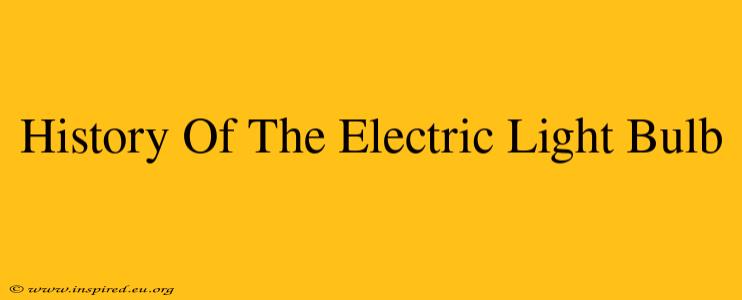The electric light bulb, a seemingly simple invention, dramatically transformed the world. Its history, however, is far more complex than a single "eureka!" moment. Instead, it represents a culmination of decades of experimentation and innovation by numerous inventors. This article explores the fascinating journey from flickering arcs to the incandescent bulbs that illuminate our lives today.
The Dawn of Electric Lighting: Early Experiments
Before Thomas Edison's famous invention, many scientists and inventors explored the possibilities of electric light. Early attempts focused on electric arcs, which produced intense light but were impractical for widespread use due to their short lifespan and high power consumption.
Humphry Davy's Arc Lamp (1809)
One of the earliest breakthroughs was Humphry Davy's arc lamp. This device used an electric current to create a bright arc between two carbon rods. While impressive, it was too inefficient and short-lived for everyday use.
Joseph Swan's Incandescent Bulb (1860s-1870s)
Joseph Swan, a British physicist, independently developed an incandescent light bulb. He successfully created a vacuum inside a glass bulb, preventing the filament from burning out too quickly. However, his early bulbs still had a relatively short lifespan.
Thomas Edison and the Commercialization of the Light Bulb
While Swan and others made significant progress, Thomas Edison is often credited with inventing the light bulb. This is because he was the first to create a commercially viable and long-lasting incandescent bulb.
Edison's Menlo Park Laboratory (1870s)
Edison's team at Menlo Park, New Jersey, systematically tested thousands of different materials for the filament. They aimed for a filament that could burn brightly and last for a considerable amount of time.
The Carbon Filament Breakthrough (1879)
After countless experiments, Edison's team found success with a carbonized bamboo filament. This filament, combined with a high vacuum inside the bulb, significantly extended the bulb's lifespan. This breakthrough was crucial for making electric lighting practical.
Beyond Edison: Refinements and Innovations
Edison's invention wasn't the end of the story. Subsequent innovations further improved the efficiency and longevity of the light bulb.
Tungsten Filaments
Later improvements involved using tungsten filaments, which provided even greater durability and efficiency. Tungsten's high melting point allowed for brighter and longer-lasting bulbs.
Fluorescent Lighting (Early 20th Century)
The development of fluorescent lighting offered a more energy-efficient alternative to incandescent bulbs. Fluorescent lights produce light by passing an electric current through a gas, resulting in a brighter and cooler light source.
LED Lighting (Late 20th & 21st Century)
Light-emitting diodes (LEDs) represent the latest major advancement in lighting technology. LEDs are exceptionally energy-efficient and long-lasting, making them an increasingly popular choice for homes and businesses. They also offer a wide range of color temperatures and dimming capabilities.
The Enduring Legacy
The electric light bulb's impact on society is undeniable. It extended the workday, enabled safer nighttime activities, and fundamentally changed how we live and work. The continuous improvements in lighting technology, spurred by initial breakthroughs like Edison's, highlight the power of innovation and its ability to reshape our world. From the flickering arc lamps of the early 19th century to the sophisticated LEDs of today, the story of the electric light bulb is a testament to human ingenuity and its enduring quest for brighter futures.
